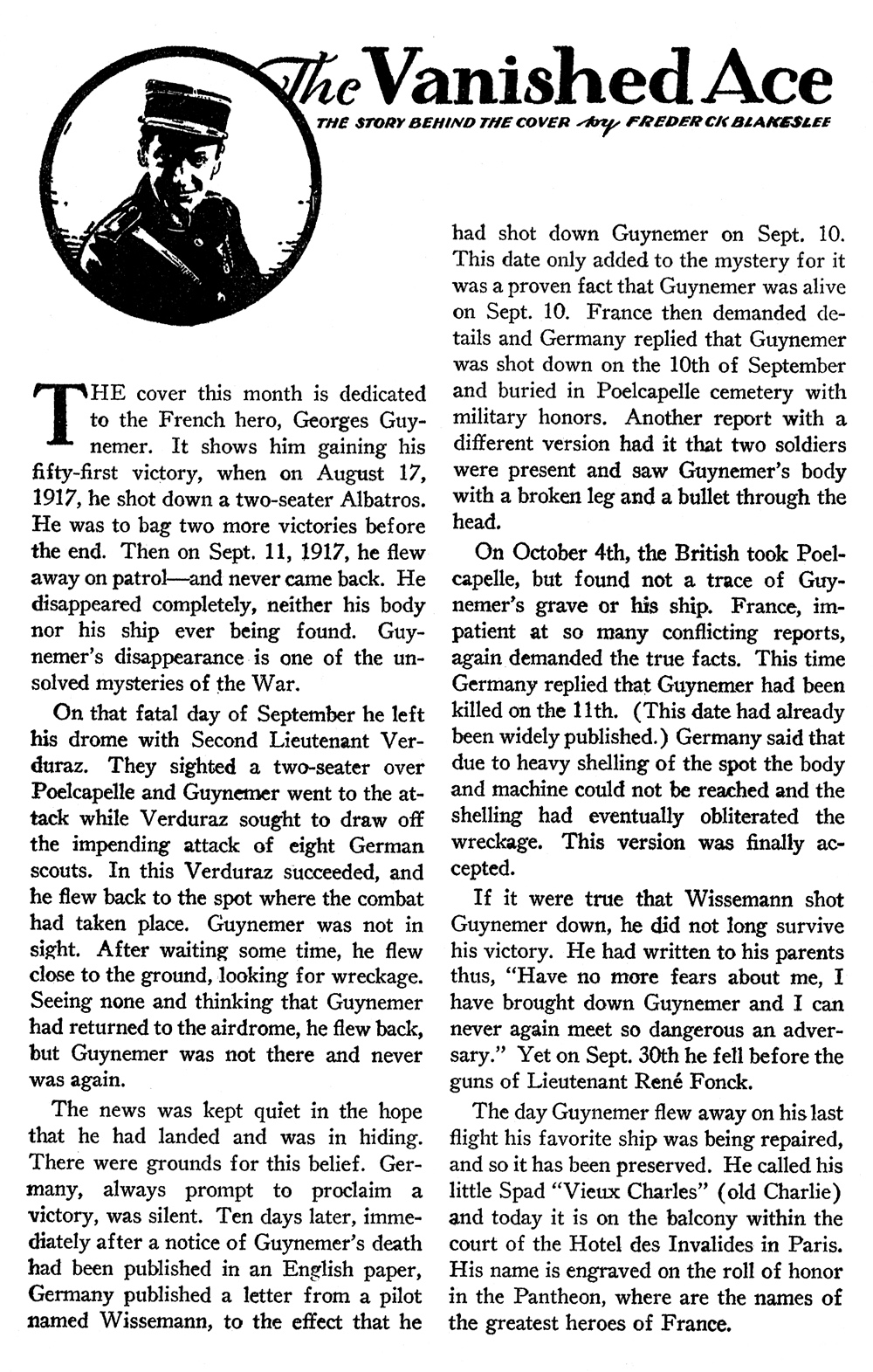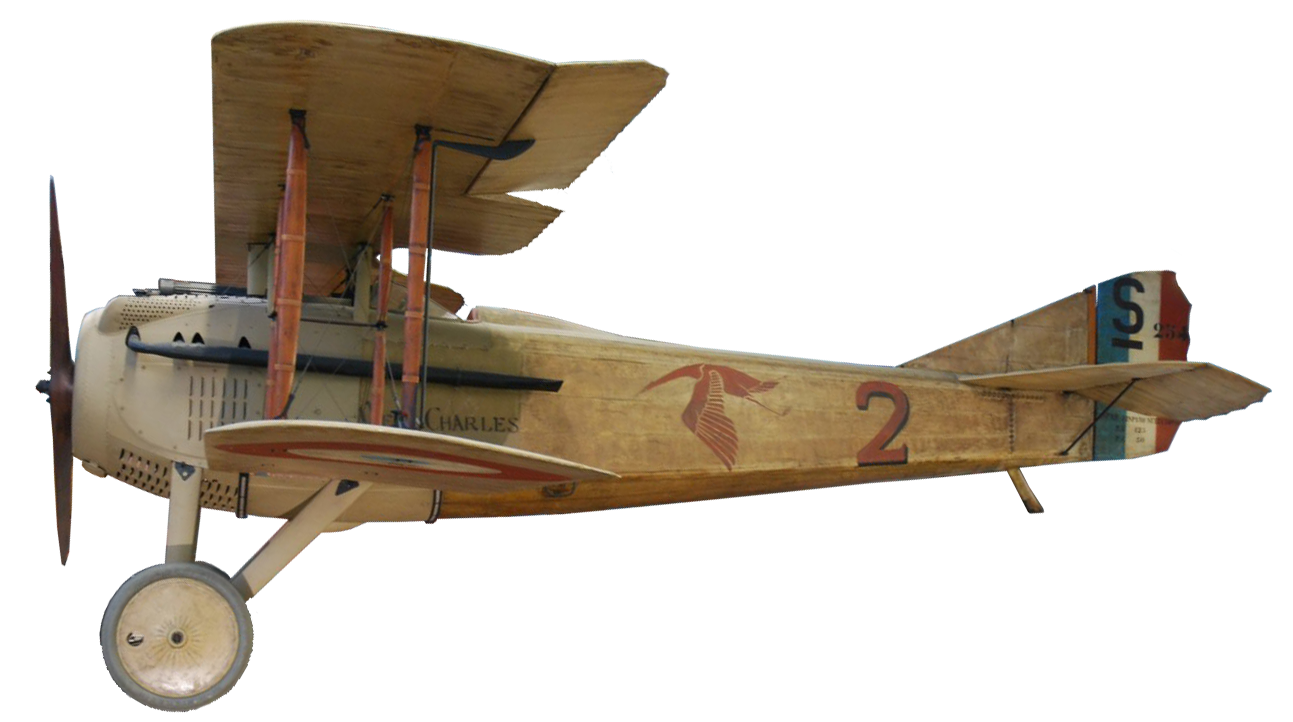“The Vanished Ace” by Frederick Blakeslee
Frederick Blakeslee painted the covers for Dare-Devil Aces‘ entire fourteen year run. Every one of those covers told a story, and Blakeslee had a page with which to do so. We present Blakeslee’s cover for the June 1933 issue of Dare-Devil Aces—his tribute to the great French Ace, Georges Guynemer—”The Vanished Ace!”
 THE COVER this month is dedicated to the French hero, Georges Guynemer. It shows him gaining his fifty-first victory, when on August 17, 1917, he shot down a two-seater Albatros. He was to bag two more victories before the end. Then on Sept. 11, 1917, he flew away on patrol—and never came back. He disappeared completely, neither his body nor his ship ever being found. Guynemer’s disappearance is one of the unsolved mysteries of the War.
THE COVER this month is dedicated to the French hero, Georges Guynemer. It shows him gaining his fifty-first victory, when on August 17, 1917, he shot down a two-seater Albatros. He was to bag two more victories before the end. Then on Sept. 11, 1917, he flew away on patrol—and never came back. He disappeared completely, neither his body nor his ship ever being found. Guynemer’s disappearance is one of the unsolved mysteries of the War.
On that fatal day of September he left his drome with Second Lieutenant Verduraz. They sighted a two-seater over Poelcapelle and Guynemer went to the attack while Verduraz sought to draw off the impending attack of eight German scouts. In this Verduraz succeeded, and he flew back to the spot where the combat had taken place. Guynemer was not in sight. After waiting some time, he flew close to the ground, looking for wreckage. Seeing none and thinking that Guynemer had returned to the airdrome, he flew back, but Guynemer was not there and never was again.
The news was kept quiet in the hope that he had landed and was in hiding. There were grounds for this belief. Germany, always prompt to proclaim a victory, was silent. Ten days later, immediately after a notice of Guynemer’s death had been published in an English paper, Germany published a letter from a pilot named Wissemann, to the effect that he had shot down Guynemer on Sept. 10. This date only added to the mystery for it was a proven fact that Guynemer was alive on Sept. 10. France then demanded details and Germany replied that Guynemer was shot down on the 10th of September and buried in Poelcapelle cemetery with military honors. Another report with a different version had it that two soldiers were present and saw Guynemer’s body with a broken leg and a bullet through the head.
On October 4th, the British took Poelcapelle, but found not a trace of Guynemer’s grave or his ship. France, impatient at so many conflicting reports, again demanded the true facts. This time Germany replied that Guynemer had been killed on the 11th. (This date had already been widely published.) Germany said that due to heavy shelling of the spot the body and machine could not be reached and the shelling had eventually obliterated the wreckage. This version was finally accepted.
If it were true that Wissemann shot Guynemer down, he did not long survive his victory. He had written to his parents thus, “Have no more fears about me, I have brought down Guynemer and I can never again meet so dangerous an adversary.” Yet on Sept. 30th he fell before the guns of Lieutenant Rene Fonck.
The day Guynemer flew away on his last flight his favorite ship was being repaired, and so it has been preserved. He called his little Spad “Vieux Charles” (old Charlie) and today it is on the balcony within the court of the Hotel des Invalides in Paris. His name is engraved on the roll of honor in the Pantheon, where are the names of the greatest heroes of France.

“The Vanished Ace: The Story Behind The Cover” by Frederick M. Blakeslee (June 1933)
According to his english wikipedia page, the red cross provided the following confirmation of his death:
Information received by the Red Cross says Guynemer was shot through the head north of Poelcapelle, on the Ypres front. His body was identified by a photograph on his pilot’s license found in his pocket. The burial took place at Brussels in the presence of a guard of honor, composed of the 5th Prussian Division. Such is the story told by a Belgian, who has just escaped from the Germans. The burial was about to take place at Poelcapelle, when the bombardment preceding the British attack at Ypres started. The burying party hastily withdrew, taking the body with them. The German General chanced to be an aviation enthusiast with a great admiration for Captain Guynemer’s achievements. At his direction the body was taken to Brussels in a special funeral car. Thither the captain was carried by non-commissioned officers and was covered with floral tributes from German aviators. The Prussian Guards stood at salute upon its arrival and during the burial, which was given all possible military honors. The French Government has been invited to place in the Pantheon, where many great Frenchmen are buried, an inscription to perpetuate the memory of Captain Guynemer as ′a symbol of the aspirations and enthusiasm of the Army.′ A resolution to this effect has been introduced in the Chamber of Deputies by Deputy Lasies.

Check back again. We will be presenting more of Blakeslee’s Stories behind his cover illustrations.




